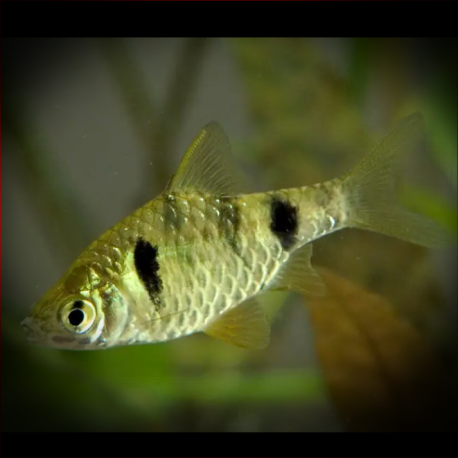More info
Datasheet
| Minimum Tank Size | 60 litres / 15.85 US gallons |
| Maximum Size | 3.0cm / 1.18inches |
| Temperature | 21°C / 69.80°F - 26°C / 78.80°F |
| Hardness | 3.03dgH / 54ppm - 12.05dgH / 215ppm |
| pH | 6.0-7.0 |
General Description
The Pethia Phutunio, commonly known as the Dwarf Barb, is a peaceful species that is best maintained alone or with other small species in a group of at least 8-10 specimens to reduce nervousness and display their best colors. Classified under the order Cypriniformes, this species is a micropredator primarily feeding on small insects, worms, crustaceans, and zooplankton. The Dwarf Barb is a schooling fish known for its striking coloration and interesting behaviors.
Aquarium Setup
For the Pethia Phutunio, a tank size of at least 60 liters is recommended, with a setup that includes a dark substrate, plenty of live plants, and driftwood to diffuse light. The fish appreciates a moderate level of water movement and does well in a hill stream-type environment. Water conditions should be maintained at a temperature between 21-26°C, pH levels of 6.0-7.0, and hardness between 54-215ppm. For detailed information on water conditions, refer to the table provided.
Behaviour
The Dwarf Barb is a schooling species that should ideally be kept in groups to enhance its natural behavior and coloration. It is a timid fish that may not thrive in a community tank due to its small size. When kept with suitable tank mates like Microdevario, Trigonostigma, and smaller Danio species, the Dwarf Barb showcases more interesting behaviors and color patterns.
Feeding and Diet
In its natural habitat, the Dwarf Barb feeds on small insects, worms, crustaceans, and zooplankton. In captivity, it should be offered a varied diet that includes live and frozen foods such as Daphnia and Artemia to enhance coloration and promote breeding conditions. While the fish can accept dried foods, they should not be the sole source of nutrition to ensure optimal health.
Reproduction & Dimorphism
The reproductive habits of Pethia Phutunio are not extensively documented, but similar species are known to be egg scatterers without parental care. To encourage breeding, a separate, dimly lit aquarium with suitable spawning substrates should be set up. Adult males of the Dwarf Barb are slimmer than females and exhibit more intense color patterns, with reddish ventral fins in males and yellow in females.
Habitat and Distribution
Natively found in the lower Ganges and Brahmaputra river basins in Bangladesh and various states in India, including Bihar, West Bengal, Orissa, Assam, and Tripura, the Dwarf Barb inhabits sluggish rivers, streams, ponds, and swamps with muddy or silty substrates, often associated with algae and aquatic plants. Records from other countries were found to be cases of misidentification.

